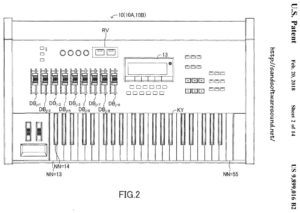“Sí, sí, I am very intrigued.”
With Summer NAMM 2018 one week away, I cast the net to see what I can catch. I did a quick sweep of recent patents and came up with a good ‘un.
When folks mention Yamaha, “tonewheel clone” does not immediately come to mind. Other players like Nord, Hammond Suzuki, etc. seem to be ahead in the clone market. So, I was a little surprised to find US Patent 9,899,016 B2, “Musical sound signal generation apparatus that generates sound emulating sound emitting from a rotary speaker.” This patent was issued and assigned to Yamaha on February 20, 2018. It is based on the Japanese patent 2015-171065 issued August 31, 2015.
Yamaha currently use two sample-based methods to generate the basic organ sound:
- Playback and mix of waveforms for each individual tone wheel. On Montage and Genos, for example, the musician can adjust the level of each footage using the sliders to mimic drawbars. The generated sound is passed through a rotary speak DSP effect.
- Playback of waveforms for “full up” organ registrations with and without the rotary speaker effect “sampled in.” The resulting sound may also be passed through a rotary speaker DSP effect.
In the first case, especially, the overall impression of a genuine B-3 depends upon the quality of the DSP rotary speaker effect. The up-side of the DSP effect is the ability to ramp up and ramp down the rotary speaker speed. So far, reaction to Yamaha’s rotary speaker effects has been mixed.
In the second case, one is not likely to put the sound through a rotary DSP effect — the swirling mass would just not be realistic. The “sampled in” approach can sound more realistic than the rotary DSP effect, but it has two major drawbacks:
- The rotary speaker speed cannot ramp up and down between slow and fast rotation.
- Sample playback does not align (synchronize) the rotary speaker position, so some noted are “rotating” faster than others and the true spatial characteristics of the horn and rotor are lost.
The second drawback is perhaps the worst of the two since it introduces audible artifacts which are not part of the true rotary speaker sound.
The method in the patent is a different take on sample-based synthesis of tone wheel sound which seeks to eliminate these problems. The notes are sampled for each tone wheel footage after a real world rotary speaker rotating at a particular rate. In each case, wavfeorms are sampled and saved for various rotational angles of the rotary speaker. Thus, the rotary speaker effect is “sampled in.”
Let’s quote from the patent:
Also, the electronic musical instrument has a time stretching function. The time stretching function is a function of changing the length of a sound while maintaining the pitch and formant of the sound. In other words, with the time stretching function, it is possible to extend and shorten a sound in a time axis direction, or in other words, it is possible to change only the reproduction speed (speed with which time advances) of the musical sound signal. The electronic musical instrument uses the time stretching function to extend and shorten each piece of waveform data in the time axis direction by the same extension and shortening rates.
Time stretching is applied to each of the tone wheel samples during playback. Thanks to time stretching, the instrument can reproduce the SLOW and FAST sound, and everything in between when the rotation speed ramps up or down. “A known pitch synchronous overlap and add method is used to achieve the time stretching function.”
The rest of the method — and it is both exhaustive and exhausting! — deals with the synchronization of the waveforms during playback, that is, the alignment of each waveform in accordance with the current virtual position (rotational angle) of the rotary speaker. Throw in separate treatment of the horn and rotor, stereo channels, etc.
The end result is a unique sample-based method that eliminates the problems of “sampled in” rotary speaker effects. I wish that patents came with audio demo files as it would be a treat to hear the method in action and to judge with one’s own ears. Maybe someday in a product?
Copyright © 2018 Paul J. Drongowski

